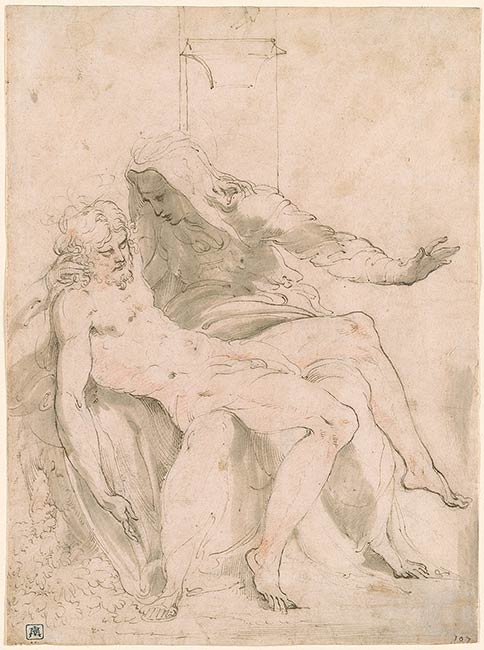
Parmigianino’s move to Rome in 1524 was apparently motivated by the hope that he would find work in the artistic enterprises of the newly elected pope, Clement VII. His arrival in Rome also offered him the opportunity for study. As recorded by Vasari in his life of the artist, “Francesco…wanted to see all the works of antiquity and the modern age, both sculpture and painting, that were in that city; but he held the works of Michelangelo Buonarroti and Raphael of Urbino in highest veneration.”1 Even before leaving Parma, the young artist was already familiar with Michelangelo’s works, probably having been shown copies by Correggio, and he seems to have traveled to Bologna to see Raphael’s St. Cecilia altarpiece there.2 He possibly met Michelangelo in Florence or at least had some access to his drawings there. Once in Rome, he fully immersed himself in the study of both Michelangelo and Raphael.3
Some of Parmigianino’s drawings after Raphael and Michelangelo are more or less straightforward copies of works by those masters, sometimes through an intermediate source such as a print by Marcantonio Raimondi.4 In the case of the present drawing, the derivation from Michelangelo’s Vatican Pietà is perfectly clear, though what is interesting is how freely and fluidly Parmigianino had begun to adapt the much-copied sculpture. The Virgin is no longer Michelangelo’s placid, contemplative figure but has become dramatically animated, extending her left arm, leaning downward to gaze at the face of her dead son, and using her right arm to lift his head and torso, seemingly after placing his limp left arm around her neck. Parmigianino also placed the fundamentally iconic sculpture in a narrative setting, indicating that the Virgin sits at the foot of the cross, which rises behind her, and also adding the foliage at lower left. The same sense of action pervades much of Parmigianino’s work made during his early period in Rome.
The Virgin Holding the Dead Christ is not, however, a casual sketch after the sculpture. The drawing is on a scale that conveys a sense of monumentality, and this, combined with the complicated, layered technique, speaks to the young artist’s ambition in taking on Michelangelo’s model. Parmigianino used faint lines of black chalk to set out the figures and then modeled the body of Christ using red chalk before adding the elegant pen lines that fix the composition and the layers of wash that define shadows and create depth. The drawing is somewhat abraded and faded today, but careful observation hints at what its original appearance must have been.
Parmigianino would continue to work with the Pietà as source material in subsequent studies. A red chalk drawing in a private collection takes the body of Christ as recast in the Morgan drawing and adapts it still further, turning the torso more to the viewer, moving Christ’s right arm to hang between his legs, and reversing the body.5 One can imagine that with several further studies and stages of adaptation, the body then evolved into that seen in Parmigianino’s experimental etchings of the Entombment, which probably also date to the same moment of his career.6
—JJM
Footnotes:
- Vasari 1878–85, 5:223.
- See Ottawa and New York 2003–4, no. 17.
- See Ekserdjian 1993.
- See, for example, his copy after Raphael’s St. Paul Preaching in Athens (Städel Museum, Frankfurt, inv. 4314) or his copy after the School of Athens (Royal Collection, Windsor, inv. rcin 990533), both illustrated in Ottawa and New York 2003–4, no. 22 and fig. 52.
- Formerly in the collections of Timothy Clifford (sold at Sotheby’s, London, 3 July 1989, lot 17) and of Jak Katalan, the drawing was with W. M. Brady & Co., Inc., New York, in 2003 and was later sold to the current owner.
- For the Entombment, see, for example, Ottawa and New York 2003–4, nos. 36–37.
Watermark: cock? with three tail feathers and crown.
The drawing is based on Michelangelo's marble "Pieta", ca. 1499, St. Peter's, Rome.
Inscribed in lower right corner, in pen and brown ink, "107".
Alziari, Franc̜ois, Baron de Malaussena, former owner.
Murray, Charles Fairfax, 1849-1919, former owner.
Morgan, J. Pierpont (John Pierpont), 1837-1913, former owner.
Morgan, J. P. (John Pierpont), 1867-1943, former owner.
Rhoda Eitel-Porter and and John Marciari, Italian Renaissance Drawings at the Morgan Library & Museum, New York, 2019, no. 79.
Selected references: Fairfax Murray 1905-12, 1: no. 47; Copertini 1932, 55n27; Popham 1971, 1: no. 311; Mantua and Vienna 1999, under no. 246; Gnann 2000, 52. London and New York 2000-2001, no. 59; Chiusa 2001, 213; Fornari Schianchi 2002, 313; Ekserdjian 2003, 58; Parma and Vienna 2003, 39; Ekserdjian 2006, 28; Gnann 2007, 1: no. 226.
Collection J. Pierpont Morgan : Drawings by the Old Masters Formed by C. Fairfax Murray. London : Privately printed, 1905-1912, I, 47.
